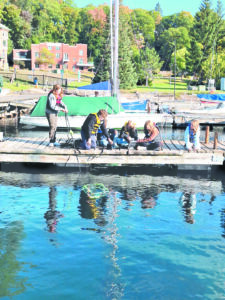What’s Flying: Seeing the difference that summer makes

STEWART
“It’s not always summer, build barns.” – Hesiod
- A male northern flicker looks on. (Scot Stewart photo)
Hesiod was an ancient Greek farmer. He lived between 650 and 750 BC. He knew the seasons brought different conditions, different weather. If he had lived in the Upper Peninsula he would have been certain a barn was necessary and built. The differences between summer and winter here are distinct, although the edges are becoming a little fuzzier every year.
Birds are an excellent example of natural features offering a chance to see those differences. Winter birds in the U.P. are basically of one kind – year-round residents. There are a few others wandering into the area – the winter finches like pine siskins and redpolls, a few other winter visitors dropping down from the Arctic – gyrfalcons, northern shrikes, rough-legged hawks, snowy, great gray, and northern hawk owls. The last, east-west migrating bohemian waxwings, seen occasionally alongside pine grosbeaks from just north of the border. Most everything else though, cardinals, chickadees, nuthatches, woodpeckers, goldfinches, mallards, ravens, and crows, tough it out are here as permanent residents.
Summer is different. During the summer months there are two, large kinds of birds – those year-rounders, and the crew flying up from the south to enjoy the bounties of the season, nectar, insects and other invertebrates, and the fish now living in ice-free waters, kingfishers and ospreys.
As the summer melts into July, it becomes easier to see the two groups, often side by side with youngsters taking advantage of the bounties of the season. Short grass fields are filled with noisy families of American crows, European starlings, and common grackles, with loud, begging offspring still looking to be fed by their parents. The common grackles are summer residents. They have become extremely noticeable in the Marquette area during the summer months. For years there were just a few spots in town where they nested in stands of cedars, like the one that formerly bordered the south gate of Memorial Field at Fair Avenue where the Berry Event Center is now located today. This year they can be found across most of town, nesting in undeveloped areas close to water.

A male northern flicker looks on. (Scot Stewart photo)
Also becoming more visible with their new fledglings, often in the same fields are northern flickers, one of two migrant woodpeckers found here in the summer. Flickers are one of the more unusual woodpeckers in the U.P. both in appearance and behavior. U.P. flickers are mostly brownish with black neck patches and breast and back spots, and red patches at the back of their heads. The undersides of their wings and tail are trimmed in yellow and visible when in flight. They also have a conspicuous white patch at the base of their tails that can make identification much easier. Males can be distinguished from females by black “moustache” patches behind their beaks.
Eastern birds were once called yellow-shafted flickers and western birds red-shafted flickers having red trim on wings and tails. Because they frequently breed along the edge of their range they are now lumped together as northern flickers. Western male birds also have red “moustaches” instead of black ones. They are all stunning birds. Although their permanent range is identified as most of the Lower 48 stats they do migrate considerably farther south in winter due to their preferred feeding area being mostly on the ground. Several years ago, one did make it almost to the Christmas Bird Count in mid-December in Marquette frequently seen at a suet feeders before disappearing.
During this time of year, they are usually showing young how to find ants on the ground, especially along curbs. By hamming the ground around hills, the ants may be draw to the surface and become easier to catch, the flickers using their very long, barbed tongue to pull them in.
Another summer visitor with some winter connections in the U.P. with a high current visibility is the cedar waxwing. This is another bird with striking markings, including a crest, yellow breast and brownish back, and bright red and yellow trim on the wings and a yellow edge to the tail. In some winters they do remain in the area and feed almost exclusively on fruit like mountain ash berries and small crab apples. Most do migrate farther south but can return to the area even before winter is over. Sometimes small numbers of them can be found foraging here in winter with migratory bohemian waxwing from the western part of the continent.
Cedar waxwings nest here in summer and have shown up on large numbers of eBird sightings reports across the entire area. One of the best ways to spot them is to watch tree tops near forest openings. They commonly roost atop trees and watch for flying insects. Once insects are spotted, waxwings will swoop out from the tree to catch the insects on the wing like flycatchers, then return to the tree and rejoin others in the flock.
Flickers and waxwings are two of the more visible summer guests currently in the area. Swallows, swifts, flycatchers, vireos, and warblers are just some of the other summer birds filling their quotas of insect collections to feed themselves and their young families. The first three may be seen as they catch their prey on the wing. The latter two will be more commonly seen in the tree branches looking for food. Sparrows like white-throats, song and swamp sparrows will be found on or near the ground, sometimes close to brown thrashers and gray catbirds. Hummingbirds, well they are also insect eaters working on flower nectar too. It is just a great time to see the difference summer makes.


